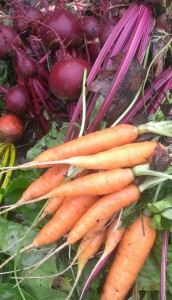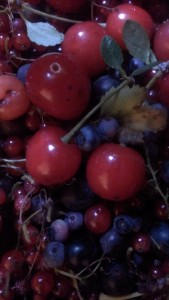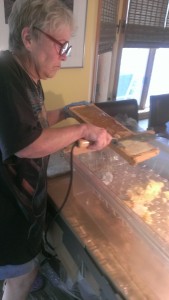Fall Harvest Moon
Got my soil tests back and the recommendations for next year’s garden. This time I asked  for specific information about beets, allium crops (onion, garlic, leeks) and tomatoes. I will use a broadcast for all the beds but use special supplements for these three crops. That way I can keep them in the same beds year after year unless some kind of disease problem occurs.
for specific information about beets, allium crops (onion, garlic, leeks) and tomatoes. I will use a broadcast for all the beds but use special supplements for these three crops. That way I can keep them in the same beds year after year unless some kind of disease problem occurs.
This time I included soil samples from the orchard, so I have recommendations for broadcast and sprays for it, too. With a winter pruning that Javier and company will do we should have a better and more consistent fruit crop next year. This year the cherries, currants, honey crisp and sweet tango were good. Plums and pears and blueberries not so much.
Since I decided a couple of years ago to get more and better crops from our limited space, I’d rate this last year a definite step in that direction. It was  a weird year weatherwise and I have no way of knowing how that helped or hurt us, but the International Ag Labs feeding program did help.
a weird year weatherwise and I have no way of knowing how that helped or hurt us, but the International Ag Labs feeding program did help.
A key aspect of the International Ag Labs program is its movement toward biosustainability so as I use their products my soil becomes better and better, not poorer and poorer as happens in much of U.S. agriculture. There are two primary goals here: soil made better by our growing and the production of higher nutrient quality produce. That’s a solid win for us and the planet at the same time. It is the Great Work in miniature, right here in Andover.
Given the outsized (for us) honey crop this year I’ve also decided to scale back my bee plans. Provided this colony survives the winter, and I think  it will, I’ll just divide it next year and not buy another package in 2014. Maybe in 2015. 2015…geez. That still seems like flying cars, shuttles to the moon and computer created meals at home. Guess I’m now the 20th century, second millennium guy anachronistically positioned in the future.
it will, I’ll just divide it next year and not buy another package in 2014. Maybe in 2015. 2015…geez. That still seems like flying cars, shuttles to the moon and computer created meals at home. Guess I’m now the 20th century, second millennium guy anachronistically positioned in the future.
Kate uncapping the honey. We’ve developed a rhythm, a working partnership when it comes to caring for the land and our plants. We share the space and the work with bees, the living organisms of the first six inches of the soil and the dogs who keep critters out of our garden and orchards.
